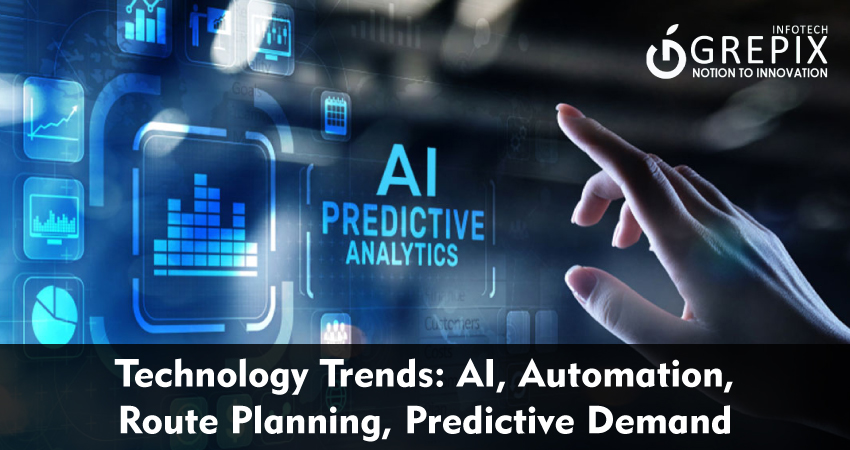Technology Trends: AI, Automation, Route Planning, Predictive Demand
The world of food delivery is undergoing a seismic transformation fueled by technology trends like AI, automation, route planning, and predictive analytics. Businesses and customers alike are reaping the rewards of smarter, faster, and more personalized services. Whether you’re a restaurant owner looking to scale, a developer crafting the next automation delivery app, or a consumer eager for seamless experiences, understanding these innovations is crucial.
This comprehensive guide explores the impact and benefits of AI in food delivery, automation delivery apps, predictive demand food apps, and the technology trends driving the future. Well-documented examples, statistics, and actionable insights will help you navigate this fast-evolving market.
Technology trends such as AI in food delivery, automation delivery apps, predictive demand food apps, and route optimization are redefining how restaurants and delivery platforms operate. Leveraging these innovations leads to faster deliveries, personalized customer experiences, higher revenue, and future-proofed businesses. Industry statistics and case studies point to accelerated market growth and stronger customer satisfaction. As AI and automation continue to evolve, the competitive edge lies in adopting smart technologies and predictive solutions that anticipate and meet consumer demand seamlessly.
The Role of AI in Food Delivery Technology Trends
Artificial Intelligence is now the backbone of modern food delivery platforms. From personalized recommendations and dynamic pricing to real-time inventory management, AI-driven systems streamline operations and elevate customer experiences.
Real-Life Examples of AI in Food Delivery
- Uber Eats: Utilizes machine learning to analyze preferences, suggest orders, and predict delivery time accurately. Its AI-powered assistant helps customers discover deals and answer queries in real time.
- Swiggy: Developed generative AI solutions for logistics—improving route planning, demand forecasting, and stakeholder conversations.
- Domino's: Employs predictive ordering to recommend popular items based on time, location, and local events, increasing conversion rates and customer satisfaction.
- Samsung Food AI: Recommends recipes using user data, available ingredients, and diet restrictions, showing AI’s flexibility and personalization.
Key AI-Driven Benefits
- Hyper-personalization boosts repeat orders and upselling.
- Inventory optimization lowers waste and improves order fulfillment.
- Enhanced safety with AI-powered allergen and diet detection.
Revenue growth for restaurants: Partnered businesses see about a 42% increase within the first year of AI-powered platform adoption.
Automation Delivery Apps: Streamlining Food Delivery
Automation delivery apps have become essential in scaling operations, reducing costs, and ensuring consistency. The market for these apps is projected to reach $225.8 billion by 2035, with a CAGR of 10.72% demonstrating robust demand and rapid adoption.
Advantages of Automation Delivery Apps
- Faster Deliveries: Autonomous bots and smart dispatch systems reduce delays and ensure hot meals.
- Reduced Functional Costs: Labor reliance drops with automated order processing, route planning, and customer support.
- Improved Customer Satisfaction: Quicker deliveries and fewer errors mean happier clients.
- Easy Driver Management: Automation delivery apps consolidate and optimize driver schedules efficiently.
- Scalable Operations: Expanding into new locations is easier with smart and automated solutions.
Case Study: EatEasy
EatEasy leverages MySQL HeatWave’s AI features to summarize food types and menus based on prior activity, optimizing customer satisfaction and boosting restaurant performance.
Route Optimization: The Heart of Food Delivery Technology Trends
Delivering food quickly, accurately, and safely requires more than just more drivers it demands optimized routes, real-time traffic analysis, and robust predictive models.
Technologies Powering Route Optimization
- AI Algorithms: Analyze order locations, traffic patterns, and weather data to suggest best possible delivery routes.
- Robotics & Autonomous Vehicles: Delivery robots and drones use AI for navigation, obstacle avoidance, and direct communication with recipients.
- Dynamic Dispatch: Apps like DoorDash use real-time driver dispatch and ETA predictions to minimize wait times.
Impactful Results
- Route optimization can reduce delivery times by up to 20%, translating to higher food quality and better customer satisfaction.
- Predictive analytics minimize delays caused by traffic, weather, or peak demand hours.
- Inventory management improves as predictive systems align kitchen readiness with delivery schedules.
Predictive Demand Food Apps: Anticipating the Future
Predictive demand food apps use big data, AI algorithms, and historical patterns to forecast what, when, and how customers will order. This not only ensures that restaurants are prepared but also that customers receive tailored, timely offers.
How Predictive Demand Works
- Order Frequency Analysis: Apps anticipate cravings based on previous orders and meal times.
- Trend Tracking: Seasonal, local, and global trends are incorporated to forecast surges (e.g., more ice cream in summer).
- Contextual Data: Weather, holidays, and nearby events influence predictive models.
- Proactive Notifications: Users are nudged with push notifications about predicted meal times and special offers.
Success Stories and Key Statistics
- Domino’s AI system customizes recommendations for game nights and local events, driving higher conversion rates.
- Just Eat leverages predictive notifications, increasing repeat order rates.
- Restaurants using predictive food apps see a 28% upsell success rate.
- Global food delivery revenue will reach $1.40 trillion in 2025, with AI in food & beverage expected to top $13.61 billion.
Future Technology: Next-Gen Food Delivery
As technology accelerates, expect the following trends to shape food delivery in the coming years:
Upcoming Innovations
- Generative AI: Powers chatbots, copilot features, and virtual assistants for personalized support and restaurant relations.
- Drone Delivery: Autonomous drone fleets take to the skies, delivering meals faster than ever and addressing accessibility challenges.
- Smart Packaging: AI-enabled packaging ensures freshness, safety, and traceability for perishable items.
- Advanced Robotics: Service robots handle delivery, customer interaction, and safety checks, enhancing operational efficiency.
Conclusion
AI in food delivery, automation delivery apps, predictive demand food apps, and the latest food delivery technology trends represent an incredible opportunity for restaurants, delivery platforms, and consumers alike. The benefits range from personalized experiences and operational efficiency to rapid growth and improved revenue. Staying ahead means leveraging these game-changing innovations now and continuously evolving alongside them.
Ready to future proof your food delivery business or app? Start by exploring AI solutions, automation platforms, and predictive demand analytics. Boost efficiency, delight customers, and grow revenue with the right strategies, your business can thrive in the tech-driven future of food delivery.
FAQs
1. How does AI improve food delivery efficiency?
AI streamlines menu personalization, demand forecasting, and route optimization, resulting in faster service and improved customer satisfaction.
2. Are automation delivery apps safe and reliable?
Yes. Modern automation delivery apps use advanced AI for error reduction, fraud prevention, and secure transaction processing.
3. What is predictive demand in food delivery apps?
Predictive demand refers to analyzing customer behavior and trends using AI to anticipate future orders, seasonal surges, and promotional opportunities.
4. Can small restaurants benefit from food delivery technology trends?
Absolutely. Smart platforms lower operational costs and provide scalable solutions, boosting revenue and customer reach.
5. What is the future outlook for food delivery technology?
Expect robust growth in AI adoption, widespread automation, drone deliveries, and sophisticated predictive analytics powering next-generation systems.







